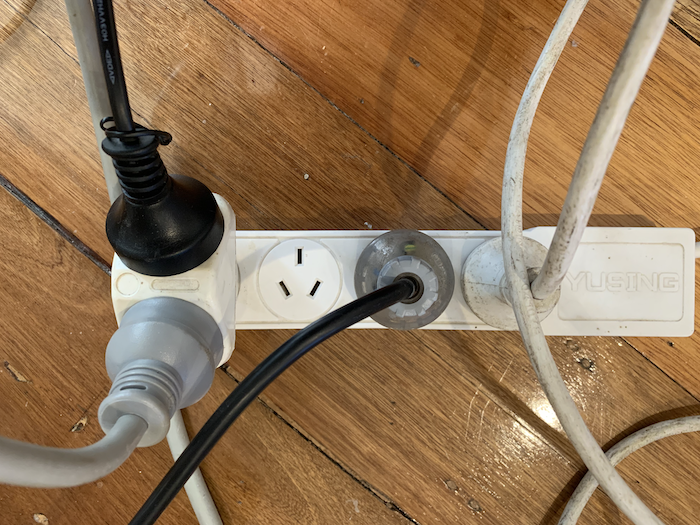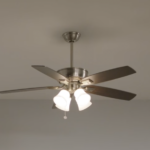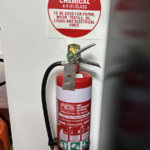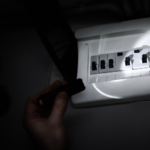
Imagine this scenario – This actually happened to me last weekend so it isn’t so hard for me to imagine, let alone forget.
You pull into the driveway after being away for a few days. The kids are in the car getting restless from the long 4-hour drive. You press the gate remote, and nothing happens….. Automatically you think the remote just must be out of batteries, that’s ok, it will all be fine.
Leaving the kids in the car screaming (they are all good, don’t worry) you climb the 2-meter fence as the gate is locked shut. You flick the gate to manual override so now it will open by hand.
The kids and you are now in the house safe and sound. But low and behold the internet isn’t working – now the kids really have something to scream about. Hold on what’s that smell? The freezer is also off. Ok so it wasn’t just the gate – Now to start your fault finding mission! Is it the gate, the internet or the freezer that’s causing the outage?
Many extension leads later I discovered it had been the power lead to the gate that had been hit by the whipper snipper – hence tripping the power off. Unlucky for me the gate power was also connected to my freezer, and the internet. The combination wasn’t the best to come home to after a weekend away.
So your power’s out, what should you do now?
Not to worry. We’ve got a quick and helpful guide that will light up your world.
But first, a disclaimer. Electricity is dangerous. We are not encouraging you to go fiddle about with something that will very likely kill you. This guide is to help you find the fault when your power goes out, not necessarily fix it – that is a job for the professionals!
Safety Tips
- Never do your own electrical repair work unless you have the know-how and are actually capable and accomplished.
- Never work on live electrical wires. It might seem a no-brainer, but sometimes we think we’re heroes. Always shut the circuit off first.
- Do not ever stand in water or on a damp floor with or without shoes when working with electricity and electrical things.
Reasons the power has gone out.

There are two main reasons why your power has gone out, namely they are external or internal.
External reasons for power failure
- We hate to be so forward here, but did you pay your electricity bill? If not, you should have seen this day coming. Pay it, and your electricity will return.
- If you have been diligent in paying your bill, the only external reason for power failure is a blackout.
Blackouts (Hello Darkness My Old Friend)
Blackouts are the real-life actualisation of our Armageddon/Zombie Apocalypse fears. To see if you’re not the only one being sabotaged, check the neighbours – the whole area might be affected. Here are the common causes of blackouts:
- Storms
- Earthquakes
- Lightning
- Fallen trees
- Animals and birds
- Vehicles crashing into electrical poles
- Extreme power demand
- Excavation digging
We realise that all of these things are sure indicators of the end of the world as we know it (if the movies are to be believed), but please. Relax. Remain calm. Take this opportunity to find your inner zen (you’re going to need it) and consider a life lived off the grid?
Internal reasons for power to go out
Assuming then all things being equal; your bills are paid, and no living dead are trawling the streets for victims, the reason for your power failure could very well be internal.
This is where you come in. You will need to go on a “fault-finding” mission. The easiest way to do this is to check your trip switches and fuses to see if there are faults with the wiring or an appliance in your home.
If the trip switch is “off” and/or some of the fuses have blown, congratulations, you have identified the problem, and if you feel confident to deal with it on your own, then read our guide on how to deal with it a few possible issues.
What is electrical fault finding?
Fault finding refers to working out what is turning the power off in your home. Normally you have an electrical power box and different parts of the home/building are connected to the different parts of the box. Normally when your power goes out there is one appliance that is ‘tripping’/turning off the power. Fault finding is the act of trying to discover which appliance in the home if flipping the power off.
Guide to finding the fault when the power goes out
Tripped fuses
- If you plugged in an appliance and the power tripped, then you’ve tripped a fuse.
- Unplug the appliance, flip the fuse switch up again and Bob’s Your Uncle.
- If when this appliance is plugged back in, the power stays on, then this appliance is not the problem.
Pro Tip: Fuse boxes all have an inbuilt safety feature to cut the power when an anomaly or fault is detected. Hooray!
- If it’s not an appliance, you have two options available to you. The first is to turn off and unplug everything on the circuit board. Reset the breaker (turn it properly off and then on again).
- If something is the matter, it will trip.
- Your second option is to go throughout your home and switch lights and plugs on and off individually to locate the source of the problem. When you find it, you can unplug it.
Pro Tip: Remember? Switch off the main electricity source before you even begin to think about replacing the fuse! Never touch the metal parts with your fingers!
Faulty circuit breakers
- If your power going out is a regular occurrence, then we suggest that there might be an issue with your circuit breaker.
- Even though these are designed to cut power when anomalies are detected or power surges happen, call an electrician to sort out the problem if it’s an ongoing issue.
Overloaded power boards

You might be one of those (amongst many others) who use power boards to increase your home’s number of electrical outlets. While this is clever, especially when these outlets are minimal, they are not designed to power your entire home and will trip when overloaded with too many devices.
- To prevent this, unplug the devices that don’t need constant power, like the hairdryer.
- Don’t string the power boards together. This is a sure-fire (pun intended) way to cause an overload!
How to evaluate power loads
- If when you plug in and switch on an appliance or electrical device, the lights dim or flicker, then that appliance or device is drawing too much power from one circuit.
- If you plug it into another power source and switch it on, and nothing happens (lights remain normal), then the issue is with the original power source and not the device. Get an electrician to come in and check out your home’s electrical service panel.
- If the lights flicker or dim when you plug it into any other power source, then the issue is with your device or appliance, and it might be a loose wire or some other fault.
Either way, we strongly advise you not to “poke the bear”. Rather get an electrician in to have a look at your home’s electrical service panel to make sure everything is up to scratch. This will also help prevent electrical fires.
How to trace a short circuit
Sometimes when you have overloaded the system, it causes a short circuit. This happens when a “hot” wire touches a neutral or ground wire, and the extra current that flows through the circuit because of this the breaker to trip or a fuse to blow.
- Check if there are black smudge marks on the receiving plugs or cover plates of light switches (where the issue occurred).
- Check your lamps, appliances and devices for frayed or damaged cords and plugs.
- Replace the cord or plug on the device. Reset the breaker and/or fuse. If all remains well, you have solved the problem. If your wiring is faulty, you need to call an electrician.
Generally, the problem is pretty easy to solve when the power has gone out. Our guide should help you with this, but if at any time you feel unsure about what you are doing, please call a professional electrician!






